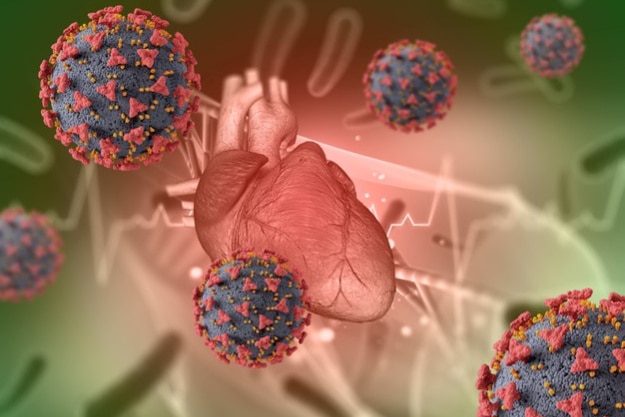Written by: Pooja Kasarapu
Medically reviewed by: Robert Philibert MD PhD
Who is at risk?
Throughout the course of the Covid-19 pandemic, news reports have repeatedly emphasized that those with existing cardiovascular (CVD) conditions are at higher risk from COVID19 than those without CVD. This risk grows steadily with increasing age.. Because many of these illnesses, such as high blood pressure, are relatively common and undiagnosed, many individuals have been living in fear and uncertainty. In this blog post, we will review with you as to how Covid-19 impacts those with heart disease and how you can stay safe during these trying times.
It is important to emphasize that not all heart diseases place you at risk.. The Centers for Disease Control and Prevention (CDC) has listed the following common conditions as risk factors for severe illness :
- Heart failure
- Coronary artery disease (also known as coronary heart disease)
- Cardiomyopathy
- Pulmonary hypertension
- Essential hypertension
These are the most common cardiovascular conditions that increase morbid risk from Covid-19, but they are not the only underlying conditions that increase risk for developing severe illness from Covid-19. In addition, there are a number of other less common cardiovascular conditions, such as prior stroke, that the CDC says may increase risk for severe Covid-19 infection.
What happens when Covid-19 infections occur in those with heart disease?
Being severely ill places additional stress on the cardiovascular system. In addition, Covid-19 infections can predispose those with certain pre-existing cardiovascular conditions to experience other adverse events. For example, those with pre-existing illness may have a higher likelihood of suffering from heart failure or blood clots. Many cells in the cardiovascular system express the receptor or viral binding protein that allow the virus to directly infect them. For example, the Covid-19 virus can directly infect the muscle cells of heart, resulting in a condition known as myocarditis (inflammation of the heart), heart failure, myocardial infarctions (heart attacks) or arrhythmias (abnormal heart rhythm) as explained by Dr. Bhudev Sharma of Hackensack Meridian Health.
How high is the risk?
Health care providers are still trying to understand the extent of the risk. Harvard Health reported that 10% of those with pre-existing heart conditions and who have contracted Covid-19 die compared to only 1% of healthy individuals who have contracted the deadly virus. Autopsy reports have shown the frequent expression viral RNA in the hearts of those who died from Covid-19. Unfortunately, the studies could not find out as to whether these victims had pre-existing heart conditions (Wichmann et al. 2020; Schaller et al. 2020). The presence of cardiovascular disease clearly increases the risk for serious illness. In a study performed in Wuhan (China) published last summer, researchers found 58% of the patients in the ICU had hypertension while another 25% had cardiovascular disease (Wang et al. 2020). Gender also may play a role. The virus appears to affect men more seriously than women due to mens’ higher levels of angiotensin-converting enzyme II (ACE2) in the cells of the heart and lining of the blood vessels which the virus uses to enter cells (Gallego et al. 2020). Overall, those under 18 are at less risk for severe illness. Nevertheless, children with pre-existing conditions should take extra precautions to stay safe. A study in Italy has shown that during the peak of its pandemic, the nation saw a 30-fold increase in Kawasaki Syndrome-like cases among children (Verdoni et al. 2020). These Kawasaki disease characteristic symptoms, such as swelling in the hands and feet and inflammation of the lips and throat, are caused by viral infections of the lining of blood vessels and are one of the increasingly more common causes of newly acquired heart disease in children.
How to stay healthy?
These are understandably stressful times for anyone especially those who have pre-existing cardiovascular conditions. However, heart health, and our health in general, has never been more important than now itself. Whenever possible, follow CDC guidelines for social distancing and mask-wearing. Dara K. Lee Lewis, MD of the Harvard Health blog recommends a healthy diet and daily exercise in order to stay active. Monitor your intake of saturated fats to reduce the risk of heart attack. For more tips on how to swap out foods high in saturated fat for the healthier alternatives, head over to the UK’S National Health Service website. As for exercising, a walk outside, some yoga or any workout of your choice is a great way to stay on your feet and keep your heart happy and healthy!
References:
- “About Kawasaki Disease” Centers for Disease Control and Prevention https://www.cdc.gov/kawasaki/about.html
- Sharma, Bhudev, “How Does Covid-19 Affect the Heart?” Hackensack Meridian Health, Aug 13 2020, https://www.hackensackmeridianhealth.org/HealthU/2020/08/13/how-does-covid-19-affect-the-heart/
- “Covid-19” Centers for Disease Control and Prevention https://www.cdc.gov/coronavirus/2019-ncov/index.html
- Gallego, Pastora et al. “Adults with congenital heart disease during the coronavirus disease 2019 (COVID-19) pandemic: are they at risk?.” Revista espanola de cardiologia (English ed.) vol. 73,10 (2020): 795-798. doi:10.1016/j.rec.2020.06.016
- “How to Eat Less Saturated Fat” National Health Society UK https://www.nhs.uk/live-well/eat-well/eat-less-saturated-fat/
- Lewis, Dara, “Covid-19 and the Heart: What Have We Learned?” Harvard Health Publishing, January 2021, https://www.health.harvard.edu/blog/covid-19-and-the-heart-what-have-we-learned-2021010621603
- Nishiga, Masataka et al. “COVID-19 and cardiovascular disease: from basic mechanisms to clinical perspectives.” Nature reviews. Cardiology vol. 17,9 (2020): 543-558. doi:10.1038/s41569-020-0413-9
- “People with Certain Medical Conditions” Centers for Disease Control and Prevention https://www.cdc.gov/coronavirus/2019-ncov/need-extra-precautions/people-with-medical-conditions.html
- Schaller, Tina et al. “Postmortem Examination of Patients With COVID-19.” JAMA vol. 323,24 (2020): 2518-2520. doi:10.1001/jama.2020.8907
- Verdoni, Lucio et al. “An outbreak of severe Kawasaki-like disease at the Italian epicentre of the SARS-CoV-2 epidemic: an observational cohort study.” Lancet (London, England) vol. 395,10239 (2020): 1771-1778. doi:10.1016/S0140-6736(20)31103-X
- Wang, Xiaowen et al. “Association Between Universal Masking in a Health Care System and SARS-CoV-2 Positivity Among Health Care Workers.” JAMA, vol. 324,7 703–704. 14 Jul. 2020, doi:10.1001/jama.2020.12897
- Wichmann, Dominic et al. “Autopsy Findings and Venous Thromboembolism in Patients With COVID-19: A Prospective Cohort Study.” Annals of internal medicine vol. 173,4 (2020): 268-277. doi:10.7326/M20-2003

